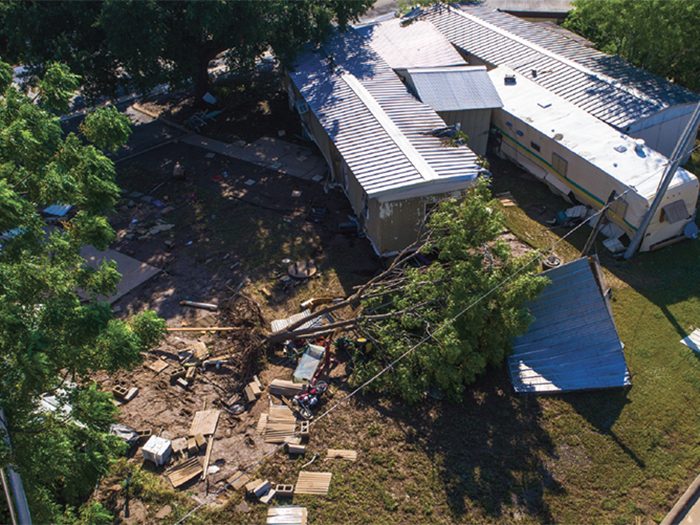Property
Insurers Take to the Skies

For Southern communities, current recovery efforts in the wake of Hurricane Harvey will recall the painful devastation of 2005, when Katrina and Wilma struck. But those who look skyward will notice one conspicuous difference this time around: drones.
Much has changed since Katrina and Wilma, both economically and technologically. The insurance industry evolved as well. Drones and other visual intelligence systems (VIS) are set to play an increasing role in loss assessment, claims handling and underwriting.
Farmers Insurance, which announced in August it launched a fleet of drones to enhance weather-related property damage claim assessment, confirmed it deployed its fleet in the aftermath of Harvey.
“The pent-up demand for drones, particularly from a claims-processing standpoint, has been accumulating for almost two years now,” said George Mathew, CEO of Kespry, Farmers’ drone and aerial intelligence platform provider partner.
“The current wind and hail damage season that we are entering is when many of the insurance carriers are switching from proof of concept work to full production rollout.”
According to Mathew, Farmers’ fleet focused on wind damage in and around Corpus Christi, Texas, at the time of this writing. “Additional work is already underway in the greater Houston area and will expand in the coming weeks and months,” he added.
No doubt other carriers have fleets in the air. AIG, for example, occupied the forefront of VIS since winning its drone operation license in 2015. It deployed drones to inspections sites in the U.S. and abroad, including stadiums, hotels, office buildings, private homes, construction sites and energy plants.
Claims Response
At present, insurers are primarily using VIS for CAT loss assessment. After a catastrophe, access is often prohibited or impossible. Drones allow access for assessing damage over potentially vast areas in a more cost-effective and time-sensitive manner than sending human inspectors with clipboards and cameras.
“Drones improve risk analysis by providing a more efficient alternative to capturing aerial photos from a sky-view. They allow insurers to rapidly assess the scope of damages and provide access that may not otherwise be available,” explained Chris Luck, national practice leader of Advocacy at JLT Specialty USA.
“The pent-up demand for drones, particularly from a claims-processing standpoint, has been accumulating for almost two years now.” — George Mathew, CEO, Kespry
“In our experience, competitive advantage is gained mostly by claims departments and third-party administrators. Having the capability to provide exact measurements and details from photos taken by drones allows insurers to expedite the claim processing time,” he added.
Indeed, as tech becomes more disruptive, insurers will increasingly seek to take advantage of VIS technologies to help them provide faster, more accurate and more efficient insurance solutions.
One way Farmers is differentiating its drone program is by employing its own FAA-licensed drone operators, who are also Farmers-trained claim representatives.
Keith Daly, E.V.P. and chief claims officer for Farmers Insurance, said when launching the program that this sets Farmers apart from most carriers, who typically engage third-party drone pilots to conduct evaluations.
“In the end, it’s all about the experience for the policyholder who has their claim adjudicated in the most expeditious manner possible,” said Mathew.
“The technology should simply work and just melt away into the background. That’s why we don’t just focus on building an industrial-grade drone, but a complete aerial intelligence platform for — in this case — claims management.”
Insurance Applications
Duncan Ellis, U.S. property practice leader at Marsh, believes that, while currently employed primarily to assess catastrophic damage, VIS will increasingly be employed to inspect standard property damage claims.
However, he admitted that at this stage they are better at identifying binary factors such as the area affected by a peril rather than complex assessments, since VIS cannot look inside structures nor assess their structural integrity.
“If a chemical plant suffers an explosion, it might be difficult to say whether the plant is fully or partially out of operation, for example, which would affect a business interruption claim dramatically.
“But for simpler assessments, such as identifying how many houses or industrial units have been destroyed by a tornado, or how many rental cars in a lot have suffered hail damage from a storm, a VIS drone could do this easily, and the insurer can calculate its estimated losses from there,” he said.
In addition,VIS possess powerful applications for pre-loss risk assessment and underwriting. The high-end drones used by insurers can capture not just visual images, but mapping heat, moisture or 3D topography, among other variables.
This has clear applications in the assessment and completion of claims, but also in potentially mitigating risk before an event happens, and pricing insurance accordingly.
“VIS and drones will play an increasing underwriting support role as they can help underwriters get a better idea of the risk — a picture tells a thousand words and is so much better than a report,” said Ellis.
VIS images allow underwriters to see risks in real time, and to visually spot risk factors that could get overlooked using traditional checks or even mature visual technologies like satellites. For example, VIS could map thermal hotspots that could signal danger or poor maintenance at a chemical plant.
“Risk and underwriting are very natural adjacencies, especially when high risk/high value policies are being underwritten,” said Mathew.
“We are in a transformational moment in insurance where claims processing, risk management and underwriting can be reimagined with entirely new sources of data. The drone just happens to be one of most compelling of those sources.”
Ellis added that drones also could be employed to monitor supplies in the marine, agriculture or oil sectors, for example, to ensure shipments, inventories and supply chains are running uninterrupted.
“However, we’re still mainly seeing insurers using VIS drones for loss assessment and estimates, and it’s not even clear how extensively they are using drones for that purpose at this point,” he noted.
“Insurers are experimenting with this technology, but given that some of the laws around drone use are still developing and restrictions are often placed on using drones [after] a CAT event, the extent to which VIS is being used is not made overly public.”
Drone inspections could raise liability risks of their own, particularly if undertaken in busy spaces in which they could cause human injury.
Privacy issues also are a potential stumbling block, so insurers are dipping their toes into the water carefully.
Risk Improvement
There is no doubt, however, that VIS use will increase among insurers.
“Although our clients do not have tremendous experience utilizing drones, this technology is beneficial in many ways, from providing security monitoring of their perimeter to loss control inspections of areas that would otherwise require more costly inspections using heavy equipment or climbers,” said Luck.
In other words, drones could help insurance buyers spot weaknesses, mitigate risk and ultimately win more favorable coverage from their insurers.
“Some risks will see pricing and coverage improvements because the information and data provided by drones will put underwriters at ease and reduce uncertainty,” said Ellis.
The flip-side, he noted, is that there will be fewer places to hide for companies with poor risk management that may have been benefiting from underwriters not being able to access the full picture.
Either way, drones will increasingly help insurers differentiate good risks from bad. In time, they may also help insurance buyers differentiate between carriers, too. &












